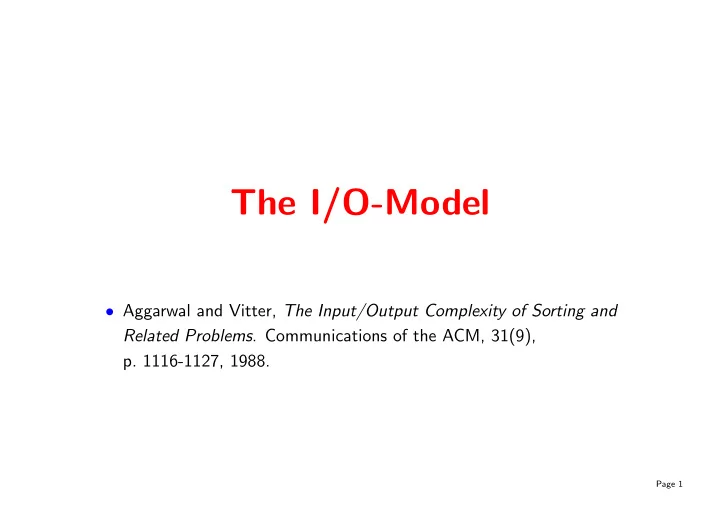

The I/O-Model • Aggarwal and Vitter, The Input/Output Complexity of Sorting and Related Problems . Communications of the ACM, 31(9), p. 1116-1127, 1988. Page 1
Analysis of algorithms The standard model: Memory CPU • Add : 1 unit of time • Mult : 1 unit of time • Branch : 1 unit of time • MemAccess : 1 unit of time Page 2
Reality Memory hierarchy: RAM Cache2 Disk Reg. Cache1 CPU Tertiary Storage Access time Volume CPU speed improves Registers 1 cycle 1 Kb faster than RAM access Cache 5 cycles 512 Kb time and much faster RAM 50 cycles 256 Mb than disk access time Disk 2,000,000 cycles 80 Gb Page 3
I/O bottleneck I/O is the bottleneck ⇓ I/O should be optimized (not instruction count) Page 4
Analysis of algorithms Memory 2 New I/O-model: Memory 1 CPU Block Parameters: no. of elements in problem. N = no. of elements that fits in RAM. M = no. of elements in a block on disk. B = no. of disks (copies of Memory 2) D = Cost: Number of I/O’s (block transfers) between Memory 1 and Memory 2. Page 5
Generic Example Consider two O ( n ) algorithms: 1. Memory accessed randomly ⇒ page fault at each memory access. 2. Memory accessed sequentially ⇒ page fault every B memory accesses. O ( N ) I/Os vs. O ( N/B ) I/Os Typically, B ∼ 10 3 . Page 6
Specific Examples Two classic sorting algorithms: QuickSort ∼ sequential access vs. HeapSort ∼ random access QuickSort: O ( N log 2 ( N/M ) /B ) I/Os HeapSort: O ( N log 2 ( N/M )) I/Os Other examples: • Hashing, radixsort (random access) • Scanning, queues (sequential access) Page 7
Recommend
More recommend